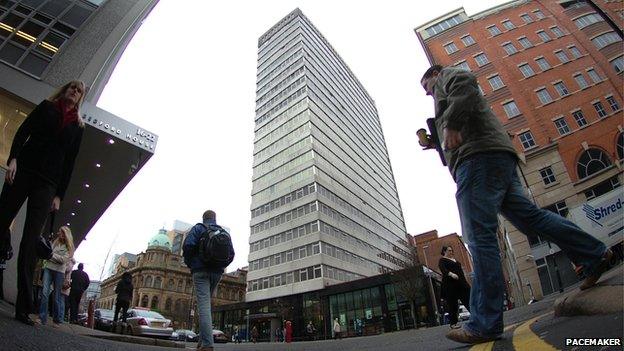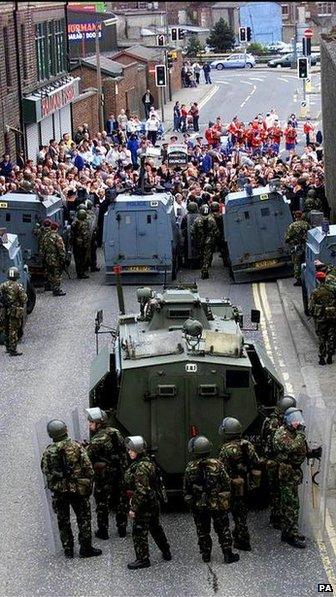Q&A: Contentious parades in Northern Ireland
- Published
Parading along public roads in Northern Ireland is a tradition among both unionists and nationalists.
Thousands of marches take place each year and the vast majority pass off without incident, but a small number of parades remain highly contentious.
Tensions usually arise when a parade organised by one of Northern Ireland's two main communities passes an area largely populated by the other community.
Some marches have led to serious riots.
Disputed marches are a reminder that there are still deep political and sectarian divisions in many parts of Northern Ireland.
Despite progress in ending the violence that had been an everyday feature of life during the Troubles, the issue of contentious parades remains one of the most intractable problems still to be resolved in the peace process.

Why are parades held in Northern Ireland?
Parades are held for a variety of reasons by many different groups.
They range from Orange marches and republican paramilitary commemorations, through to St Patrick's Day celebrations, union protests, charity events and gay pride festivals.
But the majority of parades in Northern Ireland are organised by the loyal orders, who are members of the Protestant and unionist community.
Their marching season begins in February and continues through to autumn, with the biggest annual parading festival taking place on 12 July.
Known locally as "the Twelfth", the day is a public holiday in Northern Ireland and tens of thousands of marchers, band members and supporters take to the streets to commemorate the Battle of the Boyne.

A loyalist mural depicting William of Orange's victory at the 1690 Battle of the Boyne
They celebrate the 1690 victory of William III, better known as William of Orange or King Billy. The Dutch-born Protestant defeated the Catholic forces of King James II in a battlefield outside Drogheda in what is now the Republic of Ireland.
The Orange Order, the biggest organisation in the loyal orders, traces its roots back to 1795.
The order views its parades as a celebration of Protestant religion, heritage and culture. It has described them as a "glorious display of pageantry".
However, many members of the predominantly Catholic nationalist community have said they view Orange marches as triumphalist and provocative.
Some residents have objected to marches passing through or past predominantly nationalist areas and have staged public protests against them.

Which unionist marches are the most contentious?

There has been serious rioting in Ardoyne for a number of years on 12 July
One of the most notorious parading disputes took place at Drumcree, County Armagh, in the mid 1990s, when up to 10,000 Orangemen protested against a decision to prevent their march passing a predominantly nationalist area.
However, in more recent years, the annual Drumcree march has ended with a low-key protest while violence has flared at sectarian interfaces areas in Belfast.
On 12 July in 2010, 2011, 2012 and 2013 there was serious rioting in Ardoyne, north Belfast, following the Orange Order's main annual parade.
Scores of police officers have been attacked and injured by people from both the nationalist and unionist communities, many of those involved have been arrested and the police operations have cost millions of pounds.

St Patrick's Church near Belfast city centre has become a flashpoint
But it is not just areas where Catholic and Protestant areas meet that have been affected. In July 2012, a new parading flashpoint developed outside a Catholic church on a mainly commercial street near Belfast city centre.
The controversy began when a loyalist band was filmed marching in a circle outside St Patrick's church on Donegall Street, playing a song perceived to be anti-Catholic. The band denied it was playing a tune called the Famine Song.
Since that date, bands have faced legal restrictions on their conduct outside St Patrick's, including orders on what type of music can be played as they march past the building.
The rulings angered some of the marchers and there were disturbances outside the church in August 2012, resulting in several arrests and injuries to seven police officers.

Which republican marches are the most contentious?

A republican parade in Castlederg sparked a political row
Although much fewer in number, nationalist and republican marches have also caused deep divisions in parts of Northern Ireland and some have ended in violence.
A week after violence flared outside St Patrick's Catholic church in Belfast in 2012, sustained rioting followed a parade by the republican Henry Joy McCracken flute band in the north of the city.
Loyalists objected to the Parades Commission not placing restrictions on the republican march and 47 police officers were injured during hours of violent disorder.
In August 2013, unionist politicians expressed outrage when two IRA bombers were among the republicans commemorated during a march through Castlederg, County Tyrone.
There was no disorder during or after the Castlederg parade, but it led to a bitter political row at Stormont.
Sinn Féin's support for and participation in the event also directly influenced the Democratic Unionist Party's decision to withdraw its support for the construction of a new peace centre.
The DUP called a halt to the controversial project, on the site of the former Maze paramilitary prison, just days after the Castlederg parade.

What is the Parades Commission?

The Parades Commission is based at Windsor House in Belfast city centre
The Parades Commission is the organisation set up by the government to resolve disputes caused by contentious marches in Northern Ireland.
When a dispute arises, the commission facilitates mediation between parade organisers and protesters.
When opposing sides do not reach agreement, the commission has the power to issue a ruling, imposing restrictions on either the marchers, the protesters or both.
Parades Commission rulings are known as determinations and are legally binding. Anyone found in breach of a determination can be prosecuted.
However, the organisation does not have the power to ban a march. That power lies with the Northern Ireland secretary of state.
The commission describes itself as "an independent, quasi-judicial body" and its members are appointed by the secretary of state.

Why was the Parades Commission set up?

One of the biggest parading disputes was at Drumcree in the 1990s
The Parades Commission was set up in 1997 as a direct result of the violence that followed the disputed Drumcree Orange Order parade in County Armagh.
The protracted row outside the tiny village church reverberated throughout Northern Ireland, leading to widespread protests, riots and, it is believed, several sectarian killings.
The Drumcree march had a long history, having first been held in 1807 when the area was sparsely populated, but the first serious stand-off over the parade came in 1995.
Police banned the march from going along the Garvaghy Road, an area of nearby Portadown where most of the residents are Catholic and/or Irish nationalist.
Loyalists protested by mounting a series of roadblocks across Northern Ireland and that year a limited march was allowed to pass down the road in silence.

Security forces seal off the bottom of Garvaghy Road
The following year, Drumcree was the scene of a tense, five-day stand-off when police again prevented marchers from walking along Garvaghy Road.
More than 10,000 Orangemen travelled to Drumcree to protest and an Army blockade was set up to stop the march from entering the nationalist area.
The government sent in 1,000 more troops to prevent the police from being over-stretched, but more than 50 officers were injured in days of violence.
Under pressure, the then Northern Ireland police service, the Royal Ulster Constabulary, reversed its decision to ban the march, clearing nationalist residents off the road to let the parade pass.
The RUC's U-turn infuriated nationalists and rioting broke out in other areas, including Londonderry, where 1,000 petrol bombs were thrown at police.
In 1997, a new Labour government came to power in 1997 and worked to establish an independent body that would adjudicate on marches.
The move was aimed at taking the responsibility for parade decisions away from the police, who were being criticised and violently attacked by both nationalists and unionists.
However, unionists have always been highly critical of the Parades Commission, and the Orange Order has repeatedly called for it to be abolished.